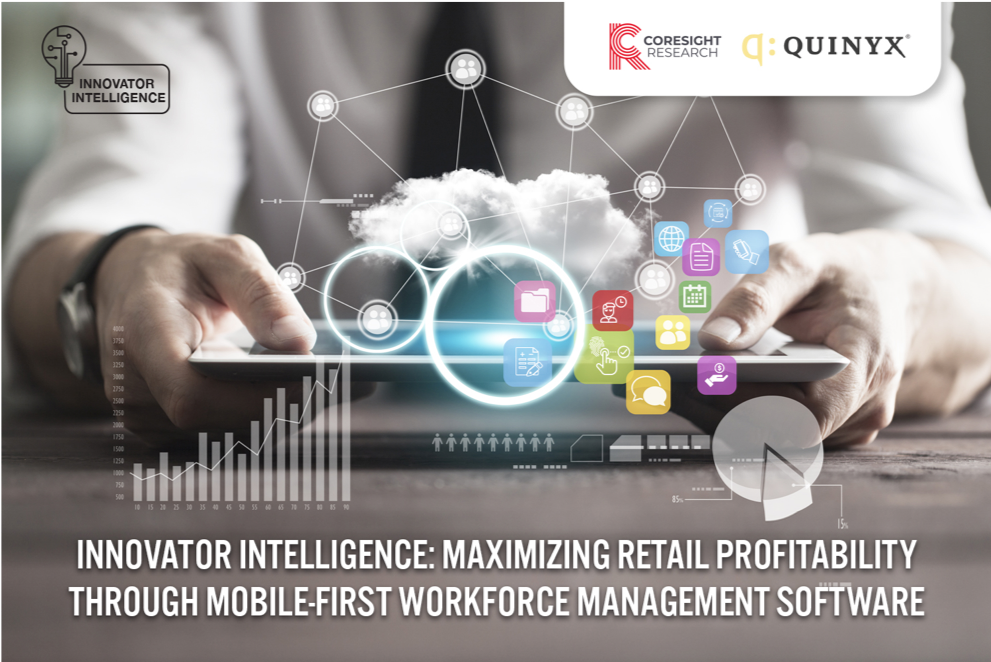
Saumya Sharma
Introduction
Businesses are built on their ability to anticipate demand, and they plan resources around those expectations. And with the long-term shift to service-driven economies, the primary resource for many companies will be the workforce. Businesses that can schedule, train and engage employees—all the while keeping those employees happy and so boosting retention—look best-placed to meet customer demands and expectations. Businesses have to choose the right workforce management (WFM) software. WFM is often a time-consuming process owing to its nature. Traditionally, WFM processes are highly fragmented because of their unique characteristics. These processes include various functions, which we summarize below. [caption id="attachment_100900" align="aligncenter" width="700"]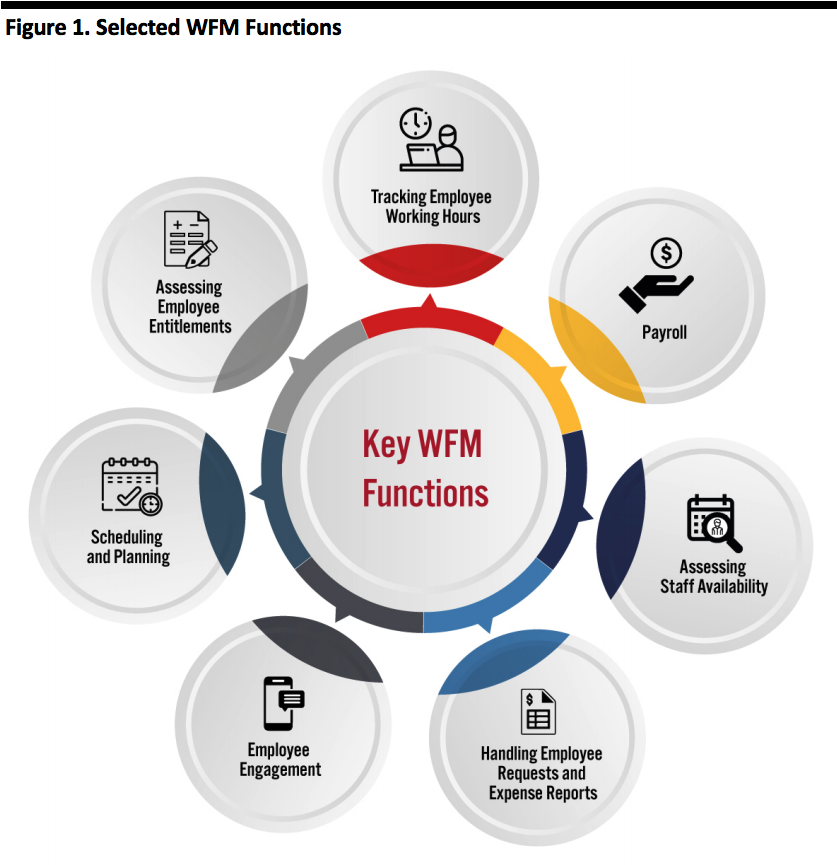 Source: Coresight Research[/caption]
In this report, we present an analysis of the key trends in the WFM market. Additionally, we discuss WFM software-as-a-service (SaaS) provider Quinyx, which provides an AI- and data-driven solution for scheduling, staffing, time reporting, communication and task management.
Source: Coresight Research[/caption]
In this report, we present an analysis of the key trends in the WFM market. Additionally, we discuss WFM software-as-a-service (SaaS) provider Quinyx, which provides an AI- and data-driven solution for scheduling, staffing, time reporting, communication and task management.
What Is WFM Software?
WFM software is a combination of various programs and functions bundled into a single application to manage the workforce more efficiently. Its key features include time tracking, scheduling, absence management and payroll maintenance. It is equally helpful to employees and employers, and helps businesses operate more transparently as employees can access their own schedules well in advance—even outside the office or store.How Can WFM Software Help Businesses?
The multiple WFM processes, which may each be undertaken for thousands of employees in any company, are susceptible to errors. For example, payroll—a basic function of any business—is an area beset by errors. This is illustrated by the increasing amount of back wages paid out to US employees each year—the difference between the wage that an employee receives and what he would have received without any payroll errors. In fiscal 2014, US employees received $240.8 million in back wages, but that climbed to $304.9 million in fiscal 2018, according to the US Department of Labor. However, administrative effort can be streamlined using WFM software as it can be easily integrated with applications such as payroll software. This can reduce payroll errors and put many disparate processes onto one platform. Businesses also benefit from cost reductions through reduced payroll management, fewer IT-related payroll costs and savings in labor-hours that can be channeled elsewhere. Overall, this leads to better time and attendance management, and also gives managers human resources (HR) analytics that can help decision making.Retail 2.0: Leveraging WFM Software To Maximize Store Profitability
WFM software can help retailers leverage advanced technologies such as AI and machine learning to enhance productivity and profitability. In this section, we discuss how WFM software can address fundamental retail challenges.- Inaccurate staffing: Miscalculations around staffing can cost retailers unnecessary labor spending during periods of low in-store traffic. Conversely, stores can experience reduced turnover if stores are understaffed when traffic surges. This reduces employee productivity. A WFM software can leverage historical data and use AI to more accurately forecast store traffic, which can in turn help stores ensure they are staffed with precision.
- Limited flexibility: Store managers face challenges in scheduling shift-hours manually, while employees have little flexibility to make changes to their work schedules. WFM software gives employees greater flexibility by letting them manage their own schedules, for example, they can swap shifts with another employee and make changes to shifts created by them, which the manager approves. And, store managers can better manage unexpected absences and find replacements more easily with a WFM solution than they can with manual shift allotment.
- Lack of visibility and control: Remote managers lack visibility of their workforce, which can further worsen because of outdated reporting tools. This can impact managers’ decision-making processes. Retailers can leverage workforce analytics to access real-time workforce insights. Managers have access to information such as hourly store traffic and what days are the busiest, which can be integrated with the WFM software to manage the store more efficiently.
Industry Overview
Workforce Analytics Market To Grow Robustly and Gain Prominence WFM enables businesses to simplify day-to-day operations and also delivers a large amount of data that can be used for analysis and interpretation. We expect workforce analytics to play an essential role in business decisions in the coming years. Not only does workforce analytics help manage employee functions, it also identifies business outcomes. These business outcomes are in turn correlated with companies’ strategic decision making. This makes workforce analytics an indispensable tool in any business. The workforce analytics market is expected to grow to $3.6 billion in 2024 from $1.9 billion in 2019, a CAGR of 13.7%, according to market research company Markets and Markets. [caption id="attachment_100901" align="aligncenter" width="700"]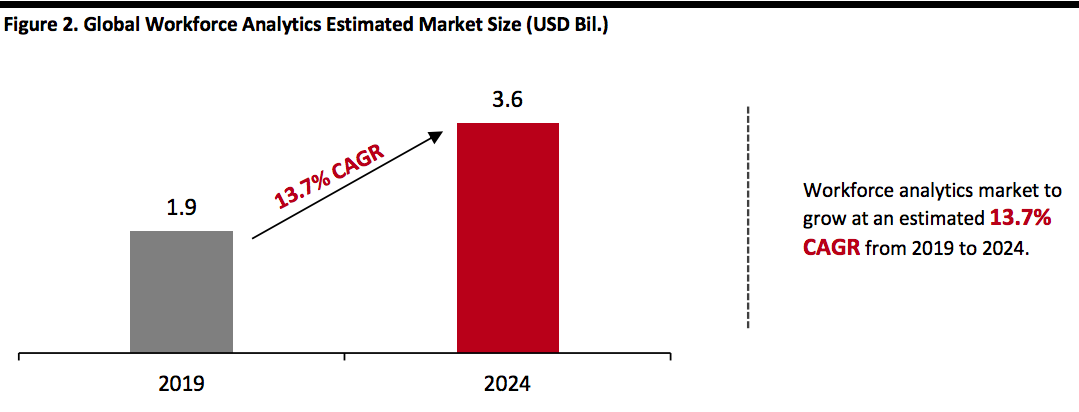 Source: MarketsandMarkets[/caption]
In practice, most organizations using workforce analytics focus on “people” data instead of looking at “people” and business processes together. In a 2017 survey conducted by Corporate Research Forum (CRF), only 21% of respondents stated they focus more on business performance than “people” issues, but more than half (57%) said that they primarily use workforce analytics for people issues.
[caption id="attachment_100902" align="aligncenter" width="700"]
Source: MarketsandMarkets[/caption]
In practice, most organizations using workforce analytics focus on “people” data instead of looking at “people” and business processes together. In a 2017 survey conducted by Corporate Research Forum (CRF), only 21% of respondents stated they focus more on business performance than “people” issues, but more than half (57%) said that they primarily use workforce analytics for people issues.
[caption id="attachment_100902" align="aligncenter" width="700"]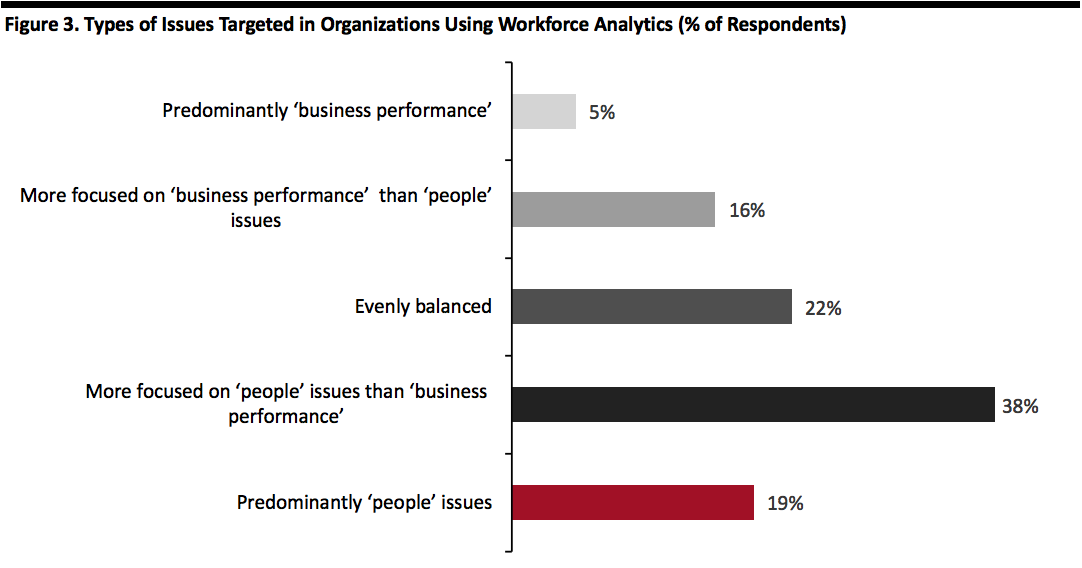 Base: 228 global HR professionals surveyed in August and September 2017
Base: 228 global HR professionals surveyed in August and September 2017Source: CRF[/caption] We expect this trend to change in the coming years as organizations and businesses gradually deploy workforce analytics for business intelligence and other insights, leveraging evolving AI and machine-learning capabilities. Nut workforce analytics projects only partly originate in the HR department: According to the same CRF survey, 20% of respondents said workforce analytics projects originated from both HR and the business, and 15% said the projects arise predominantly within the business via HR partners. Businesses realize the importance of workforce analytics in strategic decision making, and this trend will strengthen as more companies adopt workforce analytics. This will also require greater collaboration between the workforce analytics and other analytics teams. Mobile WFM To Become Mainstream in Coming Years Mobile devices are becoming an increasingly engaging and collaborative tool for workforces across organizations. We expect mobile devices such as tablets and phones to become a necessity in operating WFM processes efficiently in the coming years. The global mobile WFM market was estimated to be worth $3.4 billion in 2017 and is expected to reach $7.2 billion by 2023, according to Statista. [caption id="attachment_100903" align="aligncenter" width="700"]
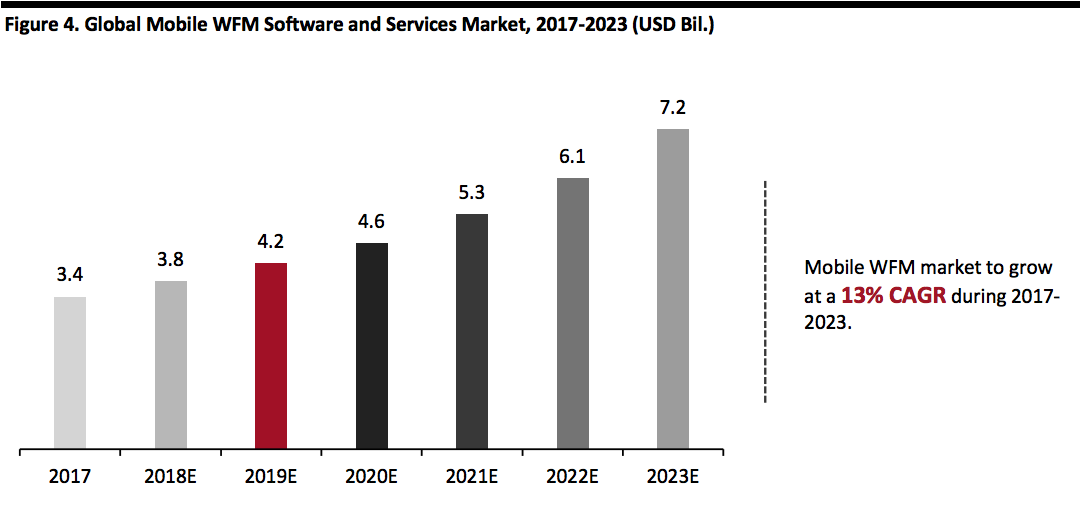 Source: Statista[/caption]
Mobile devices deliver deeper employee engagement through better communication and a wider reach, which can improve revenues. Companies with higher employee engagement experience 16% greater profitability and 37% lower absenteeism, according to Linda Ginac, CEO at talent management software provider TalentGuard.
Additional Benefits of an Engaged Workforce
Engaged employees are more likely to show up to work and finish work on time. An engaged workforce has a direct and substantial impact on business, according to Gallup. We discuss the benefits in brief below:
Source: Statista[/caption]
Mobile devices deliver deeper employee engagement through better communication and a wider reach, which can improve revenues. Companies with higher employee engagement experience 16% greater profitability and 37% lower absenteeism, according to Linda Ginac, CEO at talent management software provider TalentGuard.
Additional Benefits of an Engaged Workforce
Engaged employees are more likely to show up to work and finish work on time. An engaged workforce has a direct and substantial impact on business, according to Gallup. We discuss the benefits in brief below:
- Shrinkage and quality: Businesses with engaged workforces experience 28% less shrinkage—the dollar amount of unaccounted-for merchandise—and 40% fewer defective products.
- Safety: Engaged workers are more aware of their surroundings. Highly engaged business units realize 70% fewer safety incidents.
- Customer relationships: Engaged employees interact with customers more effectively and with better solutions to problems. Businesses with engaged workforces experience 10% higher customer satisfaction metrics and 20% higher sales.
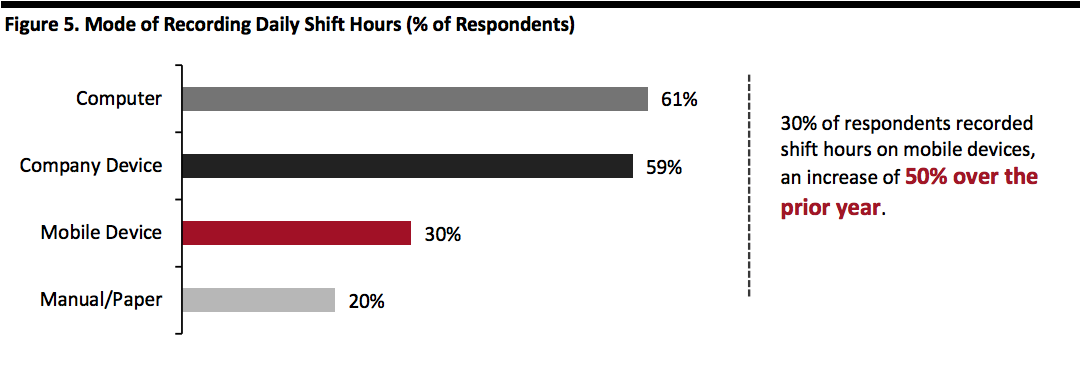 Base: 2,351 individuals across 1,312 organizations
Base: 2,351 individuals across 1,312 organizationsSource: Sierra-Cedar HR Systems Survey 2017–2018[/caption] Cloud-Based WFM Is the Way Ahead Cloud-based WFM software is more efficient and cost-effective than traditional on-premise WFM software. According to the Sierra-Cedar HR survey, 68% of respondents said cost is the primary factor in selecting a WFM application. Cloud-based WFM cuts costs as it does not need hardware, installation or IT support. Making changes to an on-premise management system can be difficult, but cloud-based WFM software is highly scalable and is monitored by the vendor—making it a more viable choice in the long-run. According to the same survey, 47% of respondents said they had a cloud-based WFM solution in place, while 54% expect to deploy one in the next 12 months. We expect this trend to strengthen in the coming years as HR information systems such as human resource management systems (HRMS) and talent management (TM) started transitioning to the cloud around a decade ago. The development is relatively new for WFM and payroll applications. Moreover, at least 95% of new WFM application sales will be deployed on the cloud by 2023, according to Gartner.
Quinyx: A Brief Overview
The Quinyx solution is unusual in that it offers WFM features such as scheduling, time, attendance, engagement and forecasting using AI in one package. We illustrate the advantages of Quinyx’s WFM offerings in the figure below. [caption id="attachment_100905" align="aligncenter" width="700"] Source: Company website/Coresight Research[/caption]
Quinyx says its WFM software has helped organizations shave up to 50% off the time spent on administration and that it can improve employee satisfaction by as much as 10%. As of June 2019, its app logins exceeded seven million per month and 90% of its clients used the mobile version.
Quinyx has signed contracts with leading retailers and brands that operate globally, including Swarovski, Gant, Domino’s Pizza, Compass Group, Kal Tire, Daniel Wellington, Rituals, L'Occitane and Thomas Sabo.
Source: Company website/Coresight Research[/caption]
Quinyx says its WFM software has helped organizations shave up to 50% off the time spent on administration and that it can improve employee satisfaction by as much as 10%. As of June 2019, its app logins exceeded seven million per month and 90% of its clients used the mobile version.
Quinyx has signed contracts with leading retailers and brands that operate globally, including Swarovski, Gant, Domino’s Pizza, Compass Group, Kal Tire, Daniel Wellington, Rituals, L'Occitane and Thomas Sabo.
Quinyx Key Offerings and Features
Quinyx says its solution helps organizations manage workforces more efficiently and with greater employee engagement. Quinyx’s WFM software works across various devices, including desktops, laptops, mobile devices and tablets. The app works on both iOS and Android. We discuss key offerings in various categories below. Scheduling and Forecasting Managers can create schedules that can save work-hours and ensure employees work on projects that best suit their abilities (based on registered skilled or experience) and at the right time. Some notable features of scheduling on Quinyx are:- Managers can create shifts based on employee skills and experience, or around the busiest times, so companies have the right people at the right place at the right time.
- With manager approval, employees can bid for open shifts, ask to swap shifts or make schedule changes directly from the user interface (mobile app or desktop). The manager is notified of the request and can approve or decline.
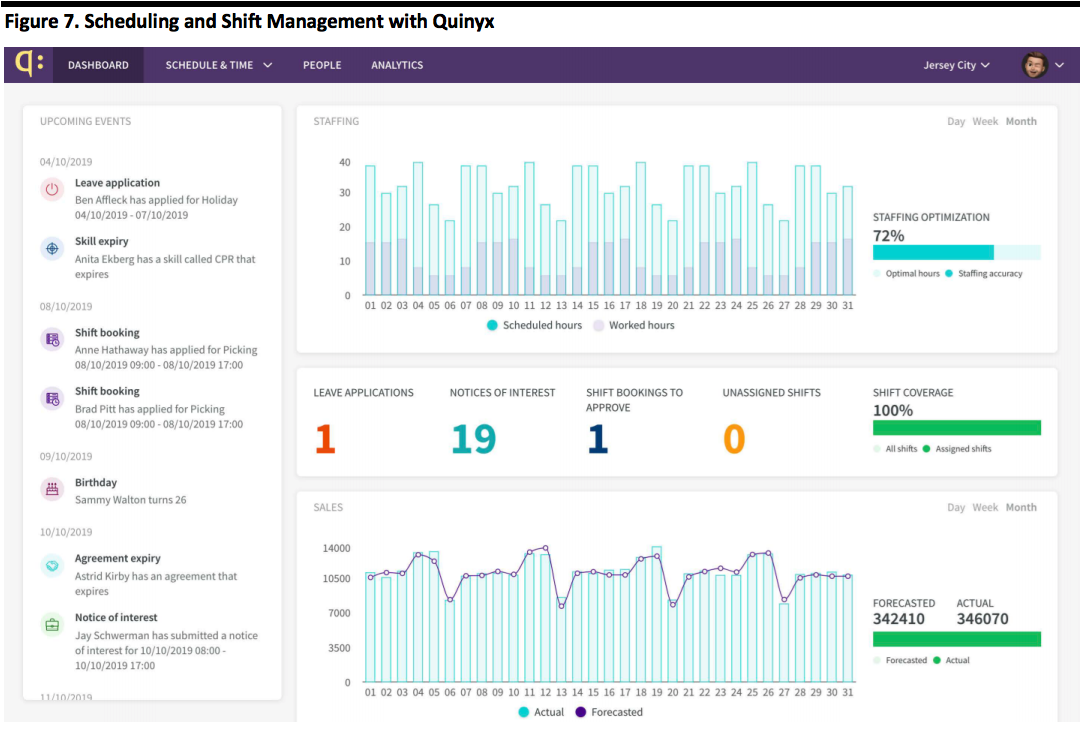 Source: Company website[/caption]
Time and Attendance
Quinyx also lets businesses integrate time reporting and absence management to support planning. Employees can punch in and out using a mobile phone or through an on-premise device, giving managers more accurate attendance data and giving employees a more seamless experience. In the figure below, we summarize the advantages of Quinyx’s web-based punch in.
[caption id="attachment_100907" align="aligncenter" width="700"]
Source: Company website[/caption]
Time and Attendance
Quinyx also lets businesses integrate time reporting and absence management to support planning. Employees can punch in and out using a mobile phone or through an on-premise device, giving managers more accurate attendance data and giving employees a more seamless experience. In the figure below, we summarize the advantages of Quinyx’s web-based punch in.
[caption id="attachment_100907" align="aligncenter" width="700"]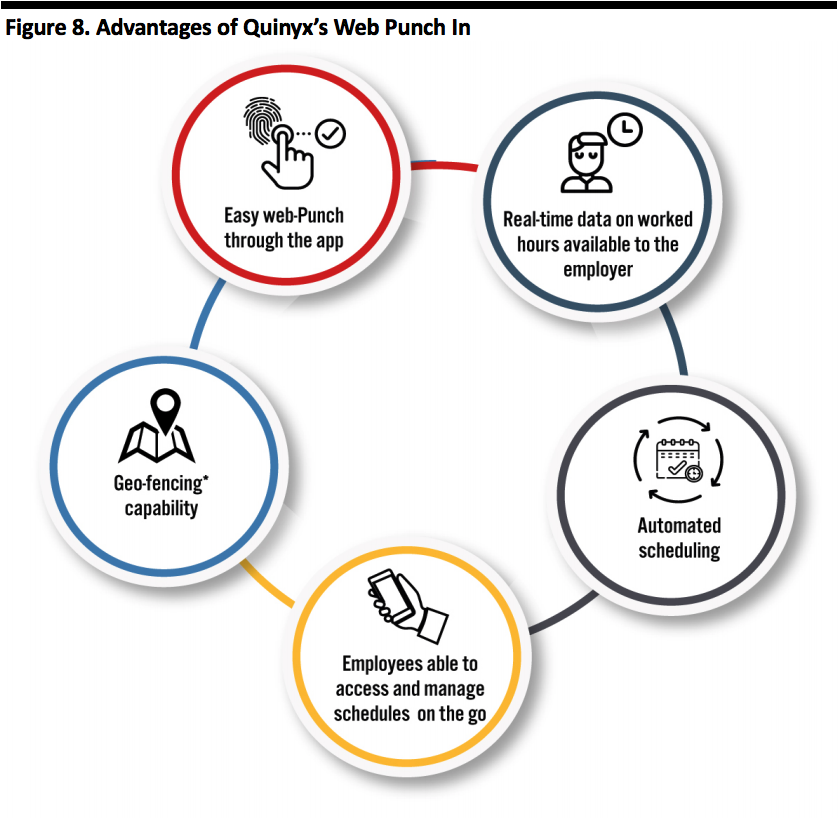 *Geo-fencing enables clients to define a certain set of coordinates, e.g. a retail store in which an employee can check in
*Geo-fencing enables clients to define a certain set of coordinates, e.g. a retail store in which an employee can check inSource: Coresight Research[/caption] Quinyx’s real-time data gives managers greater visibility of worked hours and associated costs and wage files can be processed through any payroll provider with the Quinyx open API. The interface also helps managers manage absence reports and vacations on one dashboard. [caption id="attachment_100908" align="aligncenter" width="700"]
 Source: Company website[/caption]
Employee Engagement
Quinyx’s engagement tools not only make company-wide communication easier but can also be used to keep employees up to date on company news. For example, one feature lets businesses survey workers on any topic, such as asking their employees how they are feeling, what they think about a new policy, what theme they would like the next team building to take–and so on. Businesses can also let employees recognize and reward peers with virtual badges, such as “super colleague,” “problem solver” or “always on time.”
Quinyx’s QMail email lets employees send email to specific recipient groups.
[caption id="attachment_100909" align="aligncenter" width="700"]
Source: Company website[/caption]
Employee Engagement
Quinyx’s engagement tools not only make company-wide communication easier but can also be used to keep employees up to date on company news. For example, one feature lets businesses survey workers on any topic, such as asking their employees how they are feeling, what they think about a new policy, what theme they would like the next team building to take–and so on. Businesses can also let employees recognize and reward peers with virtual badges, such as “super colleague,” “problem solver” or “always on time.”
Quinyx’s QMail email lets employees send email to specific recipient groups.
[caption id="attachment_100909" align="aligncenter" width="700"] Source: Company website[/caption]
Source: Company website[/caption]
Quinyx: Selected Case Study
How Quinyx Helped London City Airport Quinyx solved the problem of manual management for the London City Airport. Quinyx reduced the time needed to create and manage rosters by around 50%. London City Airport saw an increase in response rates to its annual employee survey after it partnered with Quinyx, from 40% to 80% in one year.Competitive Landscape
The WFM market is in its maturity phase with advanced WFM applications having the ability to transform and augment the growing market. WFM is part of a much bigger human capital management (HCM) market that offers various HR software such as HRMS and TM. Many small- and medium-sized businesses still use conventional methods to track employee hours and schedules. However, WFM has gained traction in recent years, and more advanced features such as mobility and cloud-based deployment have made WFM a lucrative choice for businesses. Below, we discuss how Quinyx has positioned itself against other market players. What Sets Quinyx Apart? [caption id="attachment_100910" align="aligncenter" width="700"]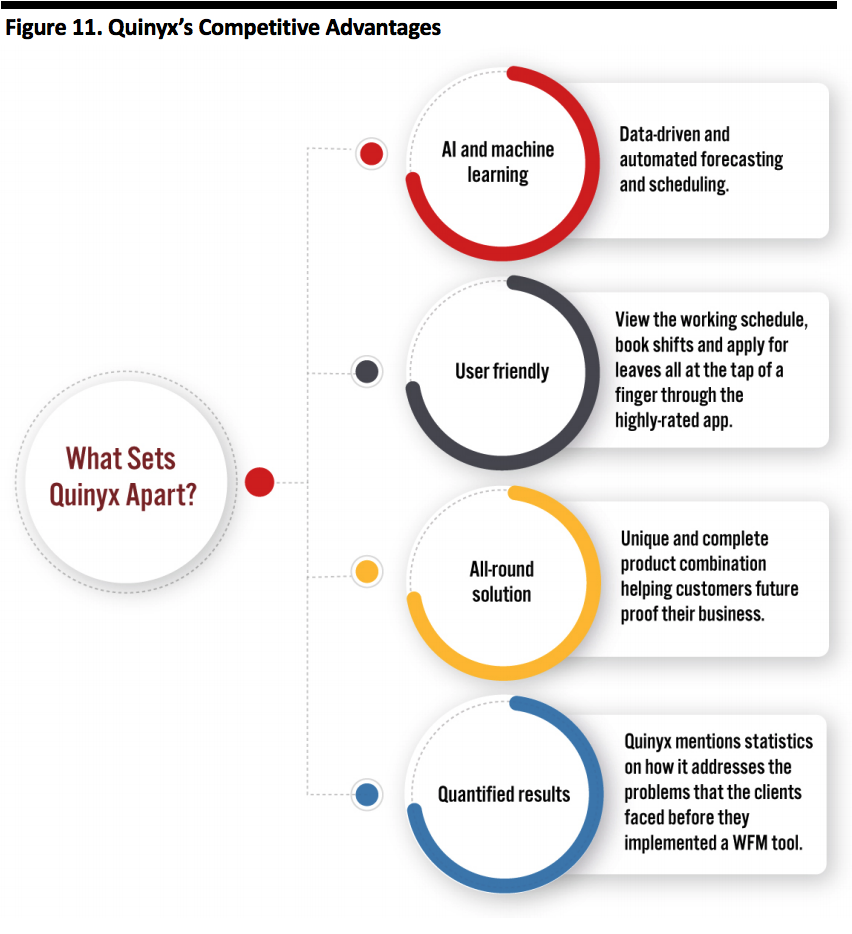 Source: Coresight Research[/caption]
Source: Coresight Research[/caption]